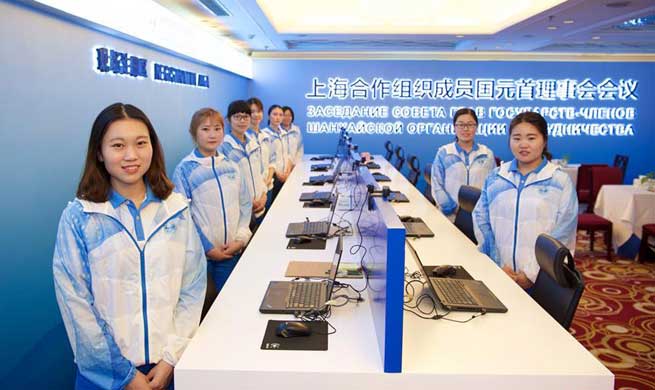BEIJING, June 4 (Xinhua) -- Three Chinese-made typhoon-resistant offshore wind turbines, one of the world's most powerful of their kind, have been running at full power this month in Xinghua Gulf, east China's Fujian Province.
Each of the turbines, with its 76.6-meter blades, has a capacity rating of 7 megawatts, and their development cost 2.3 billion yuan (358 million U.S. dollars), according to Mingyang Smart Energy, its manufacturer.
The turbines have been under operation since mid-May and in a good condition, said Zhang Qiying, chief technology officer of the company based in Zhongshan, Guangdong Province.
Tuesday marks World Environment Day.
While China has been promoting green development, clean energy including wind, solar and nuclear power has been thriving in the country, reducing its dependence on coal.
According to a national tone-setting meeting on environmental protection held in May, the country will emphasize adjusting economic structure and energy structure, fostering and expanding industries concerning energy conservation, environment protection, clean production, and clean energy.
The National Energy Administration said the total installed renewable energy capacity reached 650 million kilowatts by 2017, up 14 percent from 2016. Clean energy generated 1.7 trillion kWh of electricity last year, accounting for 26.4 percent of the country's total.
HARNESSING WIND
China's southeastern coastal areas see low wind speeds but many typhoons, which are very different from Europe which has abundant wind energy sources, said Zhang.
"Therefore, we need to address the pressure of typhoons, while utilizing them to raise the efficiency of our wind turbines," he said.
According to the Global Wind Energy Council, China ranked the third in terms of total installed capacity of offshore wind turbines, accounting for 11 percent of the world's total as of the end of 2016, after Britain and Germany.
Since 2017, several coastal provinces have released their development plans for offshore wind power, with a total installed capacity exceeding 100 million kilowatts.
Guangdong plans to build 23 offshore wind farms before 2030. Their total installed capacity will hit 66.85 million kilowatts, three times that of the Three Gorges hydropower station.
A group of wind turbines with a total installed capacity of 100 megawatts at sea off Guangdong's Zhuhai will begin operation by the end of this year. The equipment can alleviate the power shortages in nearby islets.
In China, the capacity rating of an offshore wind turbine is 1.5 to 2 times that of those on land. The new-generation wind turbines being developed are expected to have a capacity quadruple that of a land-based turbine.
The rapid development of China's offshore wind energy industry is expected to form an industrial chain of high-end offshore equipment with a value of 1 trillion yuan, said Chen Sui, chairman of CGN Energy Holdings Co., Ltd.
More importantly, China has complex conditions of ocean currents and seabed geology, and is prone to typhoons, Chen said. "Our technology that can handle these challenges is hopefully a cheaper option of clean energy for the world."
HARVESTING SUNSHINE
Since China announced its plans to support distributed solar power generation in 2012, solar panels have been mushrooming on residents' roofs, with unused generated power integrated to the national power grid.
Dong Qiang was the first to have solar panels installed on top of his villa in north China's Tianjin. Some 60 percent of the power generated by the 3,000-kW equipment is for family use, and the rest is sold to the government.
"I no longer need to pay an electricity bill, and also get around 3,400 yuan in annual income for electricity sales," he said.
By selling the generated solar power, many farmers in less-developed regions have lifted themselves out of poverty.
Li Xiaoli and her husband, from Lanping County in southwest China's Yunnan Province, have had solar panels installed on their farming greenhouses. She has also found a jobat a solar power company that was set up to help locals out of poverty.
With Li's salary, her husband's income from growing traditional Chinese medicine in the greenhouses and the income from selling electricity, the family makes 70,000 yuan a year, equivalent to their total income over the past 10 years.
"I never realized that the sun could also make people rich," Li said.
Statistics show that China's installed solar power capacity was nearly 30 million kilowatts by 2017, and is expected to exceed 160 million kilowatts by 2020, accounting for nearly 10 percent of the country's total installed electricity capacity.
EXPANDING NUCLEAR POWER
In late May, a hemispherical dome, weighing over 200 tonnes and measuring 45 meters in diameter, was installed by crane on the No. 3 unit at China's nuclear power project in Fangchenggang. The project used Hualong One technology, a domestically-developed third generation reactor design.
The installation was finished eight days ahead of schedule, marking the beginning of the assembly stage, according to the China National Nuclear Corporation (CNNC).
Construction of Unit 3 and Unit 4, as Phase II of the Fangchenggang plant, will provide reference for the proposed Bradwell B plant in Essex in Britain, as China has won the U.K. deal.
Hualong One was jointly designed by China's two nuclear power giants, China General Nuclear Power Group and CNNC, and passed inspection by a national panel in August 2014.
As of last November, China had 37 operational nuclear reactors and is building a further 19.
Total installed nuclear power capacity in operation was nearly 36 million kilowatts, ranking fourth worldwide. The volume is expected to reach 58 million kilowatts by 2020, with the number of under-construction nuclear reactors leading the world for many years.
The country's clean energy endeavor has paid off.
Due to the thriving clean energy of various kinds, coal consumption, a major contributor to the country's air pollution, has reduced by 8.1 percent over the past five years, according to the government work report in March.
A report released by the International Energy Agency last October said China alone was responsible for over 40 percent of global renewable capacity growth in 2016.
"China is the undisputed renewable growth leader," said the report.

















